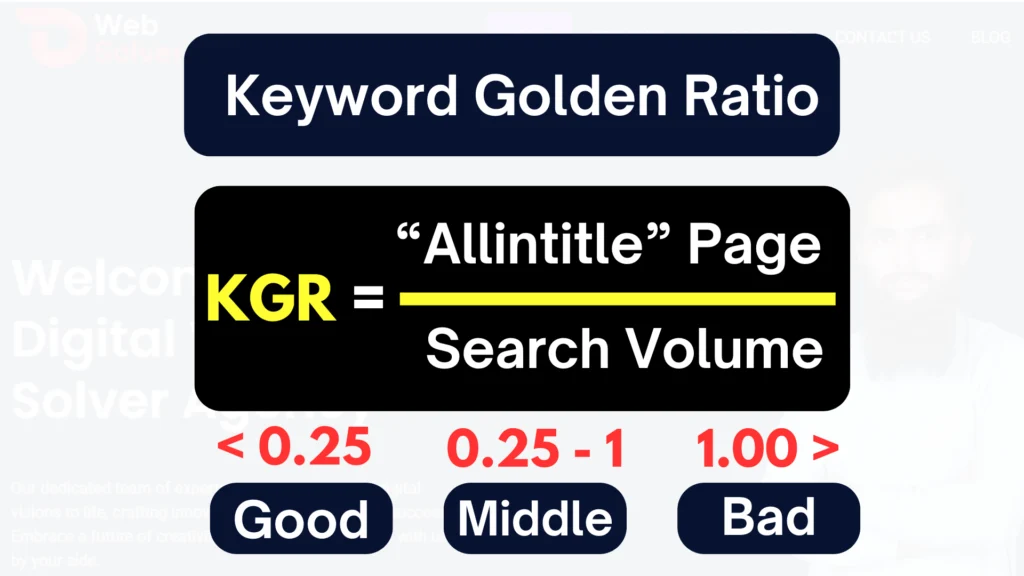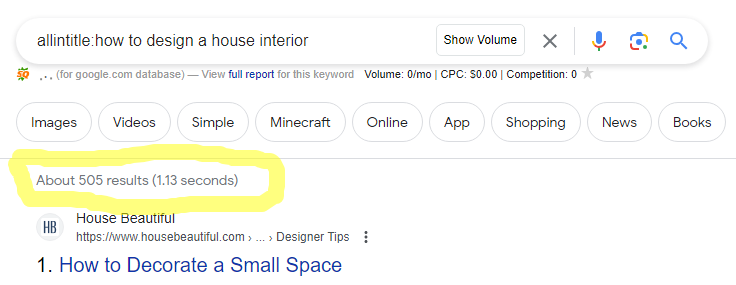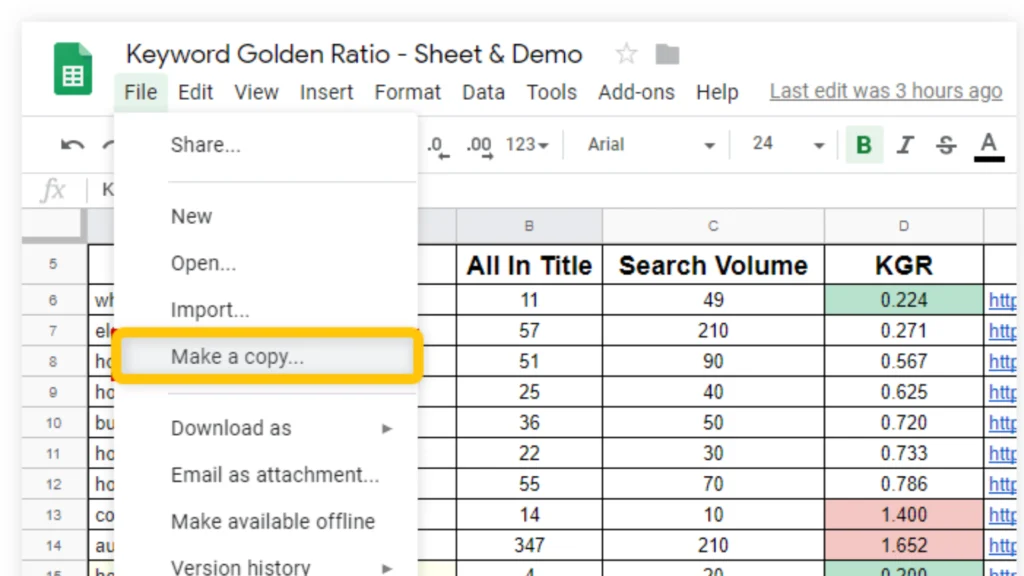The Keyword Golden Ratio (KGR): Enhancing Organic SEO
In the realm of blog content strategy, numerous approaches exist for selecting topics that resonate with your audience. One of these invaluable strategies is harnessing the power of the Keyword Golden Ratio (KGR). In this comprehensive guide, we will explain what the KGR entails and how to wield it effectively for bolstering your organic SEO efforts.
Understanding the Keyword Golden Ratio (KGR)
At its core, the Keyword Golden Ratio (KGR) is a data-driven methodology designed to unearth long-tail keywords that are underutilised within Google’s search result pages. This ratio is determined by dividing the number of Google search results featuring the keyword in their titles by the local monthly search volume, particularly when the search volume falls below the 250 mark.
How to Calculate the KGR Ratio?
When you identify a keyword that aligns with the KGR and craft content tailored to that keyword, your article has the potential to ascend to the top 10 search results in a matter of days, if not hours. For websites that possess a degree of authority and aren’t entirely new, a top 5 ranking might even be achievable.

Elaborate the “Allintitle”
To embark on this journey, it’s essential to grasp the concept of “Allintitle.” This advanced Google search operator sifts through results, specifically looking for websites where the chosen words appear verbatim in the article’s meta-title.

Unlock the Beauty of Proportions with Golden Ratio Calculator
Discover the elegance of the golden ratio through user-friendly calculator. This tool simplifies the process of identifying the shorter and longer segments of a line, as well as their combined value, using a straightforward formula.
In this formula, we denote the longer segment as “a” and the shorter one as “b.” The golden ratio can be easily derived with the following equation:
(a + b) / a = a / b
Calculating the golden ratio manually is a breeze. Just follow these simple steps:
- Begin by selecting the longer side or value and designate it as “a.”
- Next, choose the smaller side or value and label it as “b.”
- Apply the formula: (a + b) / a = a / b
- Calculate (a + b) and divide the result by the value of “a.”
- Calculate “a / b.”
If your final answer is approximately equal to 1.5, congratulations! Your quantities exhibit the captivating beauty of the golden proportion.
Evaluating Keyword Difficulty Using the KGR Method
To illustrate how KGR operates, let’s consider the keyword “best story book for men” and follow these steps:
Determine Search Volume: Begin by ascertaining the search volume of the term, which, in this instance, stands at 6510 according to Keyword Surfer.
Unveil “Allintitle” Results: The next step involves extracting the “allintitle” or search results number, which, in our case, totals 3000.
Calculate KGR: The KGR for “best Story book for men” is computed as 0.46 (3000/6510).
It’s important to note that any KGR less than 1 holds promise for inclusion in your blog posts and articles, especially if the search volume is below 250. However, in scenarios where the term, despite having a KGR less than 1, yields over 7,000 results, it’s advisable to exercise caution, as per the following KGR guidelines:
- KGR < 0.25: Expect to rank within the top 100 results after Google indexes your page.
- KGR between 0.25 and 1: Anticipate swift entry into the top 250 results.
- KGR > 1: Signifies a competitive search term, making it challenging to secure a high-ranking position.
In essence, the rule of thumb is to craft articles that target keywords with the following attributes:
- Search volume less than 250.
- KGRs less than 1, with a preference for those below 0.25.


| Section | Allintile | Volume | KGR Formula |
|---|---|---|---|
| Section 1 | 505 | 1000 | 505 / 1000 = 0.505 |
| Section 2 | 200 | 800 | 200 / 800 = 0.25 |
| Section 3 | 750 | 1500 | 750 / 1500 = 0.5 |
| Section 4 | 300 | 1200 | 300 / 1200 = 0.25 |
| Section 5 | 1000 | 2000 | 1000 / 2000 = 0.5 |
| Section 6 | 400 | 1600 | 400 / 1600 = 0.25 |
| Section 7 | 600 | 1800 | 600 / 1800 = 0.3333 |
| Section 8 | 800 | 1400 | 800 / 1400 = 0.5714 |
| Section 9 | 250 | 750 | 250 / 750 = 0.3333 |
| Section 10 | 1200 | 2400 | 1200 / 2400 = 0.5 |
Leveraging Keyword Tools for KGR-Compliant Terms
Now, let’s explore how to discover KGR-compliant terms using the KWFinder tool:
Find Relevant Keyword Ideas: Initiate your quest by utilizing tools like Google Autosuggest or, for greater efficiency, opt for KWFinder. This tool’s advanced filtering and keyword difficulty evaluation streamline the process. Select “Autocomplete,” input your search phrase, and click “Find keywords.”
Filter Keywords: Assess the unfiltered list of results, paying close attention to search volume and keyword difficulty, as other parameters hold less significance at this stage.
Refine Your List: Click on the “Filter” button to obtain a refined list, excluding keywords with the highest search volumes. This yields a selection of keywords with monthly searches below 250.

Utilize “Allintitle” Results: Employ Google’s advanced search command, “allintitle,” to identify the number of websites featuring titles that precisely match those in your refined list.
Calculate KGR: Apply the KGR formula, where KGR = (“allintitle” results) divided by (search volume). For instance, if you have 22 “allintitle” results and a search volume of 7310, the resulting KGR is 0.14, indicating compliance with the KGR criteria.
KWFinder not only streamlines the process but also provides valuable metrics for each keyword, enabling competition analysis without the need to leave the application.
Tools for Discovering KGR Terms
Finding KGR terms that are easy to rank for can be a challenge, but there are tools to assist you:
- UberSuggest: This SEO tool offers insights into a keyword’s monthly search volume, primary keywords competitors rank for, new keyword suggestions, and estimates of competition in organic and paid SEO.
- SpyFu: SpyFu allows you to uncover keywords used by your competitors, helping you generate an initial list of keywords within your industry that can be further refined.
- Keyword Surfer: This free extension provides search volumes, cost per click (CPC), keyword suggestions, and related terms for each Google search you perform, all within your browser.
Keyword Density in SEO: Striking the Right Balance
Keyword density, a measurable indicator, represents the frequency of a keyword’s appearance in an article. It serves as a vital element of SEO, aiding experts in gauging the keyword’s presence in a webpage’s content. Calculated using the formula:
KDI = (NO/NT) x 100
DI = (NO/NT) x 10
Where:
- KDI: Keyword density index
- NO: Number of keyword occurrences in the article
- NT: Total word count of the article

Most SEO practitioners recommend maintaining an ideal keyword density of approximately 1 to 2%. This ensures that the target keyword appears often enough to convey the page’s subject to search engines, without overwhelming the content with excessive keyword usage.
Conclusion:
In conclusion, the Keyword Golden Ratio represents a powerful technique for optimizing your SEO efforts. It offers a fresh perspective on long-tail keywords, allowing your content to receive the attention it rightfully deserves. The key lies in targeting keywords that strike the right balance of competitiveness, and the KGR rule serves as a reliable compass in this endeavor.
For SEO experts, the consensus often revolves around maintaining a keyword density ranging from 1% to 2%. Striking this delicate balance ensures that your chosen keywords effectively convey the content’s subject to search engines, without overloading your pages with excessive keyword usage.
Ultimately, the Keyword Golden Ratio emerges as a game-changer in the realm of SEO strategy, guiding you toward content success in the digital landscape.
Also Read:
- Top 6 Guest Posting Freelancing Platforms in USA & UK
- What is Guest Posting And Importance Of Guest Posting in SEO?
FAQ
1. How do you find the golden keyword?
Finding a “golden keyword” involves conducting keyword research to identify a keyword or keyphrase that has a high search volume and low competition. Tools like keyword research software or platforms can help you discover such keywords.
2. What is the Keyword Golden Ratio (KGR) in a niche site project?
The Keyword Golden Ratio (KGR) is a formula used in niche site projects to determine the competitiveness of a keyword. It’s calculated by dividing the number of Google search results with the keyword in the title by the keyword’s monthly search volume. A KGR value below 0.25 is considered favorable for niche site content.
3. What is the KGR strategy?
The KGR strategy involves targeting low-competition keywords with a high likelihood of ranking well in search results. By using the Keyword Golden Ratio, content creators aim to find these keywords and create content around them to attract organic traffic.
4. What is the golden ratio used for?
The golden ratio, often denoted as φ (phi), is a mathematical concept used in various fields like art, architecture, and design to create aesthetically pleasing proportions and balance. It’s used to achieve harmony and balance in visual compositions.
5. What are keywords for SEO in a niche?
Keywords for SEO in a niche are specific words or phrases relevant to a particular industry or topic. These keywords help search engines understand the content of a website or page and improve its visibility in search results, ultimately driving targeted traffic.
6. Why is it called the golden ratio?
The golden ratio earned its name from its Greek origins. In the world of mathematics, this special numeric value is known as “phi,” in honor of the renowned Greek sculptor Phidias. The term “golden ratio” itself stems from its widespread use in Greek architecture, particularly in the design of structures like the Parthenon, located in Athens, Greece.







